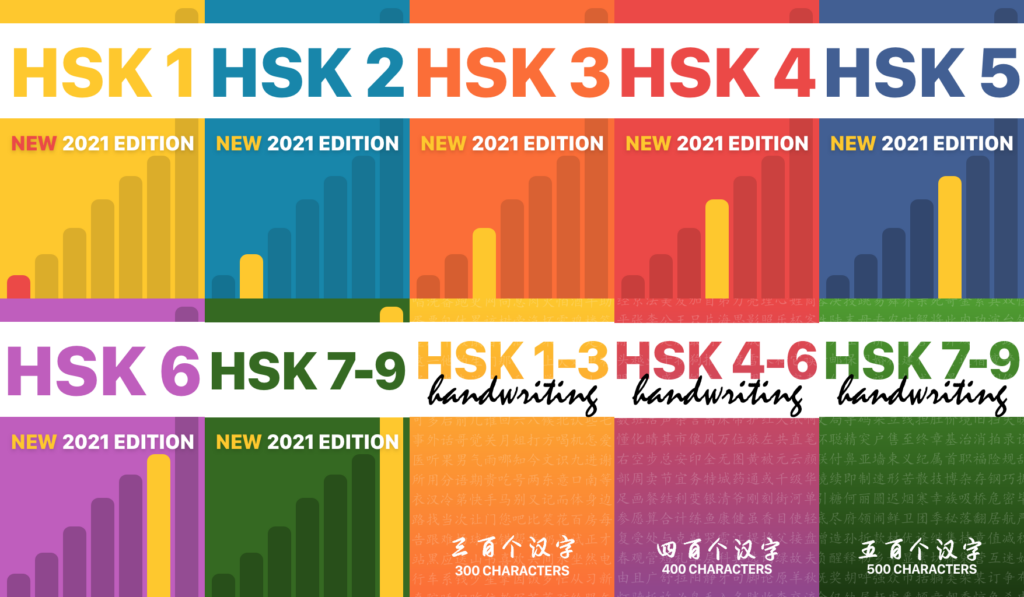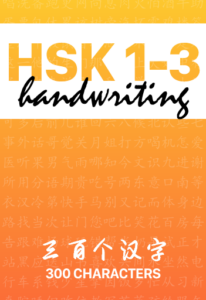
As many of you already know, changes are coming to the HSK (Hànyǔ Shuǐpíng Kǎoshì, 汉语水平考试), the most widely used proficiency test for Mandarin Chinese for non-native speakers. In this article, I’m going to summarise what we know about these changes and what they mean for you as a student of Chinese.
As many of you already know, I also work for Skritter (learn more about Skritter here), and recently, Jacob Gill and I have spent a lot of time creating vocabulary lists for the new HSK 1-9, including separate lists for handwriting. Links to those are included at the end.
Tune in to the Hacking Chinese Podcast to listen to the related episode:
Available on Apple Podcasts, Google Podcast, Overcast, Spotify and many other platforms!
Here’s a breakdown of the content in this article fore easy access:
- Basic facts about the new HSK 3.0
- What the new HSK 3.0 means for you as a student
- HSK as a roadmap for learning Chinese
- For those who really need an HSK certificate
- Vocabulary lists in Skritter
Basic facts about the new HSK 3.0 (2021)
The first thing that is important to note is that there has been much speculation online about the new HSK, some of which has little support in official communications from Hànbàn (汉办), an institution affiliated with the Chinese Ministry of Education, and responsible for administering the test. In fact, at the time of writing (June, 2021), many things about the new HSK are unknown, including much of the timetable for the new tests.
That doesn’t mean that we don’t know anything about HSK 3.0, though. Most of what we do know comes from a new proficiency standard that takes effect on July 1st, 2021, called 国际中文教育中文水平等级标准 (guójì zhōngwén jiàoyù zhōngwén shuǐpíng děngjí biāozhǔn, or “Chinese Proficiency Grading Standards for International Chinese Language Education”). The document, which can be downloaded from the Ministry of Education here, specifies nine bands grouped into three levels of proficiency, including what students should be able to do at each level, and a list of characters, words and grammar points for each.
The HSK exams, courses and textbooks are expected to be updated to follow this new standard, which entails that major changes are coming. However, a new standard taking effect and rolling out new exams with new learning materials are two completely different things. It’s true that the standard itself takes effect on July 1st, 2021, but that is merely the date when implementation starts, not when it’s supposed to be finished!
Hànbàn has said that the new advanced bands (7-9) will be rolled out first, starting with pilot tests in December 2021, and then following with the official exam becoming available in March 2022.
When it comes to HSK 1-6, the changes will be gradually implemented over 3-5 years, and we should not expect any major changes in the near future. They particularly state that current exams, certificates and learning materials are still valid and will continue to be so for the foreseeable future.
Naturally, no one can predict the future, so don’t be surprised if the above information later turns out to be inaccurate or if the official HSK 3.0 tests are pushed even further into the future.
Many things about the language content are also uncertain. Most importantly, it’s not guaranteed that there’s a 1:1 correspondence between the standard document and the actual exams. For example, it’s possible that some things are optional or could be part of a separate exam. The current HSK exams can be done digitally, for example, so while the new HSK does have standard for handwriting specifically, it’s not inconceivable that this might still be optional. The same might be true for other things, so take everything I say here (and everything everybody else says, except maybe official sources) with a pinch of salt!
What the new HSK 3.0 (2021) means for you as a student
For most people, changes to the HSK have little or no impact on their studies. Remember, the HSK is just a measurement of your language ability, and an imperfect one at that. Unless you need an HSK certificate for a specific purpose, you do not need to care much about HSK at all, and you can safely ignore all discussions about what might or might not happen a few years down the line.
In fact, you can stop reading this article now and do something that will actually improve your Chinese instead! Why not check out our Skritter’s YouTube channel? Or learn vocabulary and grammar by following Skritter on Instagram? Go for it!
Still here? Cool, let’s talk about HSK 3.0, but let’s do it in a rational manner without freaking out over how many words a certain level now has or the fact that the exam will now test handwriting specifically.
 There are many students who care a lot about HSK, probably because it provides a roadmap for learning Chinese. That’s fine! But remember, the HSK is just a yardstick against which you can compare certain aspects of your proficiency; it’s not the language itself!
There are many students who care a lot about HSK, probably because it provides a roadmap for learning Chinese. That’s fine! But remember, the HSK is just a yardstick against which you can compare certain aspects of your proficiency; it’s not the language itself!
Changing the yardstick does not change what it measures. I’ve seen many students who are dismayed by the fact that the level they are working towards now will be equal to a lower level according to the new standard. For example, the current HSK 3 contains roughly the same amount of vocabulary as the new HSK 1 (600 and 500 words respectively). If we measure only vocabulary, someone currently at HSK 3 would then in theory be “downgraded” to HSK 1.
So what? Your Chinese proficiency does not change because of how many words are listed under a certain number in an official document. The language itself does not suddenly become harder because more is required for a certain level on an exam. Your ability to communicate in Chinese is the same on June 30th as it is on July 1st. Nothing has changed.
 Being upset about one’s ability being “downgraded” from HSK 3 to HSK 1 is a bit like a golfer being disappointed that their drive is suddenly shorter when measured in metres instead of yards after taking a flight to a European tournament: “Oh, I guess I’m 10% worse than I was yesterday.” That’s clearly nonsense, and so is worrying about your Chinese being “downgraded”.
Being upset about one’s ability being “downgraded” from HSK 3 to HSK 1 is a bit like a golfer being disappointed that their drive is suddenly shorter when measured in metres instead of yards after taking a flight to a European tournament: “Oh, I guess I’m 10% worse than I was yesterday.” That’s clearly nonsense, and so is worrying about your Chinese being “downgraded”.
The way we measure something like this does not change the thing measured. The map is not the territory. A proficiency test is not the language itself.
HSK as a roadmap to learning Chinese
Except when how you measure really does matter. Like I said before, for many people HSK functions as a roadmap, and if the HSK changes, so will the roadmap.
For example, if something is required on the HSK, some people will think that it’s more important than if it isn’t (and for some people, it will be). Words that are on the HSK will seem more relevant than words that aren’t. I’ve written more about using HSK as a roadmap to learning Chinese here:
With that in mind, let’s look at a few important changes, but again keeping in mind that we don’t know exactly if or how these will be implemented in actual tests:
 Handwriting – The ability to write characters by hand is included in the new proficiency standard, along with more in-depth knowledge about characters. It is as yet unclear exactly how this will be tested, but for HSK 1-3, copying characters within an allotted time is mentioned, starting with 10 per minute for band 1, 15 per minute for band 2, and then 20 per minute for band 3. Knowledge about characters and character structure is also required. There are 300 characters in total for HSK1-3 (click here to view/study the deck in Skritter). For HSK4-6, copying characters is not mentioned, but an increasing understanding of Chinese characters will be required. There will also be an additional 400 characters for HSK 4-6. For HSK7-9, another 500 characters are added to the handwriting list.
Handwriting – The ability to write characters by hand is included in the new proficiency standard, along with more in-depth knowledge about characters. It is as yet unclear exactly how this will be tested, but for HSK 1-3, copying characters within an allotted time is mentioned, starting with 10 per minute for band 1, 15 per minute for band 2, and then 20 per minute for band 3. Knowledge about characters and character structure is also required. There are 300 characters in total for HSK1-3 (click here to view/study the deck in Skritter). For HSK4-6, copying characters is not mentioned, but an increasing understanding of Chinese characters will be required. There will also be an additional 400 characters for HSK 4-6. For HSK7-9, another 500 characters are added to the handwriting list.- Translation – A major change in the new HSK is that starting from band 4, translation is part of the requirements. We don’t know yet exactly what this means, but as outlined in the standard document linked to above, it starts with basic translation and interpretation for HSK 4, and ends with what amounts to professional level ability for HSK 9. This seems a bit odd, considering that translation is merely one way in which a language can be used. It also makes me wonder how they are going to deal with source/target languages. Will I be able to translate to or from Swedish?
For good or ill, I think it’s safe to say that this will lead to more people caring about handwriting and translation. Remember what I said above, though, this only has a direct impact on your studies if you care about an official certificate!
I, for example, have studied Chinese for 14 years and have never taken an official HSK exam. Why? Because I’ve never needed the certificate. I have taken many mock exams, though, and have sat the TOCFL many times (Test of Chinese as a Foreign Language, the standard proficiency test in Taiwan). I did the mock HSK exams and official TOCFL exams for benchmarking purposes, but I also took the latter twice, the first time because it was required for a scholarship, and the second time because it was required in the Master’s program in teaching Chinese as a foreign language that I was enrolled in.
For those who really need an HSK certificate
So, what if you do care about your HSK score and you need the certificate for something? This needs to be something rather specific, since having a certificate is not immediately useful in itself in most contexts.
Then the new HSK probably still won’t influence your studies much, at least not yet!
Let’s look at a few different situations:
- You’re a beginner or intermediate learner (current HSK 1-5) – The new HSK will take time to affect you. The levels you are interested in won’t change for years (see above). By the time the new tests really come out, you’ll have advanced way beyond your current level. The future you might already be using Chinese in your job, teaching the language or working as an interpreter. Who knows? Conclusion: You can safely ignore the new HSK 3.0 for now. If you do need a certificate, the current HSK 2.0 is the only option.
- You’re an advanced learner (current HSK 6 or above) who needs a certificate – The current HSK 6 will be around for years (see above), you have plenty of time to get the certificate if you don’t already have it. We don’t know how the rest of the world will react to the new HSK, though. For example, HSK 6 is currently the highest level, but starting from next spring when HSK 7-9 land, will companies and institutions then suddenly demand HSK 9 where they currently only require HSK 6? Maybe. In some cases, more advanced Chinese really would be required, but I can also see less well-informed companies and institutions raising the bar without really knowing what it means in practice. And going from current HSK 6 to the new HSK 9 is really raising the bar quite a lot.
- You’re an advanced learner (current HSK 6 or above) who’s looking for a challenge – The good news regarding HSK 3.0 is that it will better cover the full range of language proficiency. For example, the CEFR (Common European Framework of Reference for Languages) contains the levels A1-2, B1-2 and C1-2, where A1 is the lowest and C2 is the highest. According to various Chinese teachers’ organisations in Europe, the current HSK 6 is roughly equal to B2. That leaves C1-2 uncovered. The new HSK 7-9 will largely deal with this range of proficiency, giving advanced learners a way to challenge themselves and also to prove their proficiency if they wish to do so. It also extends the roadmap beyond HSK 6, which is nice, although I think that most people at this level probably have found their own way.
Character and word lists in Skritter for HSK 3.0 (2021)
 Since Skritter is an app largely focused on learning characters and words, it might seem odd that I haven’t mentioned the vocabulary part of the exam materials so far in this article (apart from the handwriting bit, which I did mention). This is because word lists for exams that won’t be available for a long time actually aren’t all that useful. In fact, basing your learning on word lists in the first place is a dubious practice. Still, word lists can be a good supplement, so we have of course made sure that we have you covered.
Since Skritter is an app largely focused on learning characters and words, it might seem odd that I haven’t mentioned the vocabulary part of the exam materials so far in this article (apart from the handwriting bit, which I did mention). This is because word lists for exams that won’t be available for a long time actually aren’t all that useful. In fact, basing your learning on word lists in the first place is a dubious practice. Still, word lists can be a good supplement, so we have of course made sure that we have you covered.
Here’s what we have done so far:
Decks containing the vocabulary for HSK 1-9
 These decks cover all the new vocabulary split by band and level, sorted by frequency within each deck. The original lists are in alphabetical order, but that is typically bad for learning and since some of the lists are rather long, it matters greatly that you are learning the most important vocabulary within each band first. The frequency data here is based on a combination of different sources. Here are direct links to the seven lists (HSK 7-9 is in one giant list in the official document):
These decks cover all the new vocabulary split by band and level, sorted by frequency within each deck. The original lists are in alphabetical order, but that is typically bad for learning and since some of the lists are rather long, it matters greatly that you are learning the most important vocabulary within each band first. The frequency data here is based on a combination of different sources. Here are direct links to the seven lists (HSK 7-9 is in one giant list in the official document):
Decks containing the characters to write by hand for HSK 1-9
 The following decks cover the characters specifically listed for handwriting knowledge in the new HSK. These are grouped by level, so there are three decks in total. At the time of writing, we only know that for HSK 1-3, there will be 100 for each, but we don’t know which 100, so we have simply sorted that deck into an order we think is best for students, using a weighted average of several sources, trying to predict which characters are most important for learners.
The following decks cover the characters specifically listed for handwriting knowledge in the new HSK. These are grouped by level, so there are three decks in total. At the time of writing, we only know that for HSK 1-3, there will be 100 for each, but we don’t know which 100, so we have simply sorted that deck into an order we think is best for students, using a weighted average of several sources, trying to predict which characters are most important for learners.
Further support
What other kinds of support would you like when it comes to the new HSK? Leave a comment below or contact us! Here are some thing we think would be helpful, but haven’t had time to implement yet:
- Single character decks – The official document contains lists of single characters that are covered in various levels of the exam.
- Differences between HSK 2.0 and HSK 3.0 – While Skritter users can just start learning from the new HSK 3.0 lists and automatically only get the characters you didn’t already know, it might be interesting to study the characters that have been added for the new version.
- Important words left out of HSK 3.0 – I while back, I did an analysis of high-frequency words that are left out of or delayed in HSK 2.0. A similar analysis will be made for HSK 3.0 as well, showing you what you might miss if you only study the official vocabulary lists.
- Guide to handwriting characters – We already offer a character course that teaches you all the basic concepts you need to make sense of and learn Chinese characters. We will expand this by taking you through not just 150 common characters and components, but eventually all the characters required for handwriting.
- Time attack for the new HSK 3.0 – The time attack mode currently allows users to compete themselves and others to see who can write characters the fastest. This seems like a perfect fit for the new handwriting requirements, so we will update time attack mode to focus on these characters instead.
That’s it for now! I will update this article in case of major changes, but the contents above should keep you covered for now! If you want to know more, you can keep reading some of the suggested links below.
Further reading
 汉语考试服务网, the official site for HSK information and registration, available both in Chinese, English and a bunch of other languages. This is where we expect official information about the new tests to appear eventually.
汉语考试服务网, the official site for HSK information and registration, available both in Chinese, English and a bunch of other languages. This is where we expect official information about the new tests to appear eventually.- HSK Official on Twitter shares updates related to the HSK in various ways.
- HSK official account on WeChat (微信), requires you to have an account and be logged in
- 国际中文教育中文水平等级标准, the official document detailing the standard the new HSK will be based on. The document is in Chinese, but Dig Mandarin has a good article in English that looks mostly accurate.
- HSK on Wikipedia, which is great if you want a simple overview of the exam, including some history and the comparisons with CEFR referred to in this article.
- This post on SE Chinese Language contains a collection of visual comparisons regarding vocabulary in HSK 2.0 and HSK 3.0

Tips and tricks for how to learn Chinese directly in your inbox
I've been learning and teaching Chinese for more than a decade. My goal is to help you find a way of learning that works for you. Sign up to my newsletter for a 7-day crash course in how to learn, as well as weekly ideas for how to improve your learning!